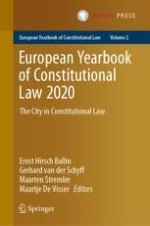2021 | OriginalPaper | Buchkapitel
11. The City of London: Dominance, Democracy, and the Rule of Law?
verfasst von : Paul Burgess
Erschienen in: European Yearbook of Constitutional Law 2020
Verlag: T.M.C. Asser Press
Aktivieren Sie unsere intelligente Suche, um passende Fachinhalte oder Patente zu finden.
Wählen Sie Textabschnitte aus um mit Künstlicher Intelligenz passenden Patente zu finden. powered by
Markieren Sie Textabschnitte, um KI-gestützt weitere passende Inhalte zu finden. powered by
